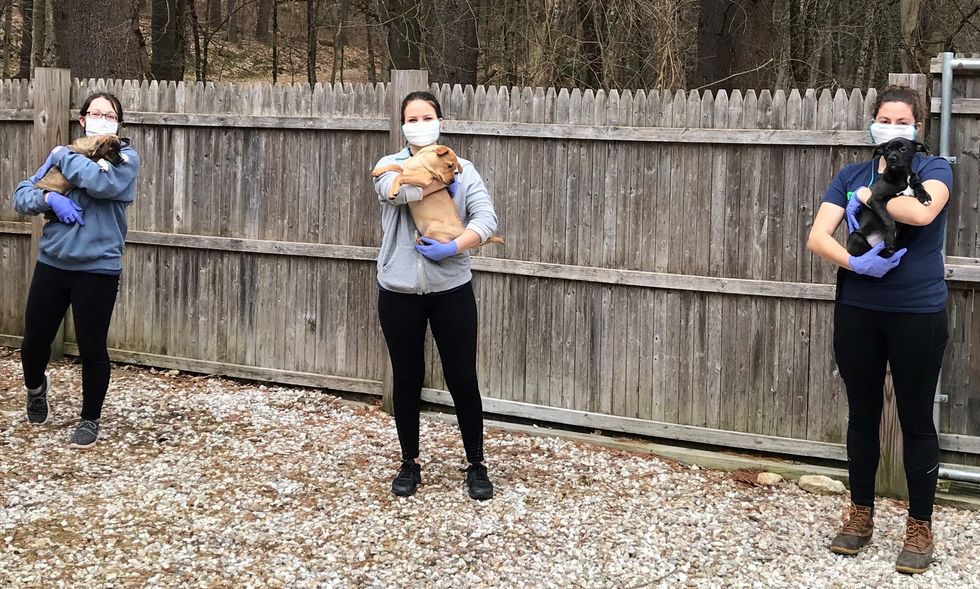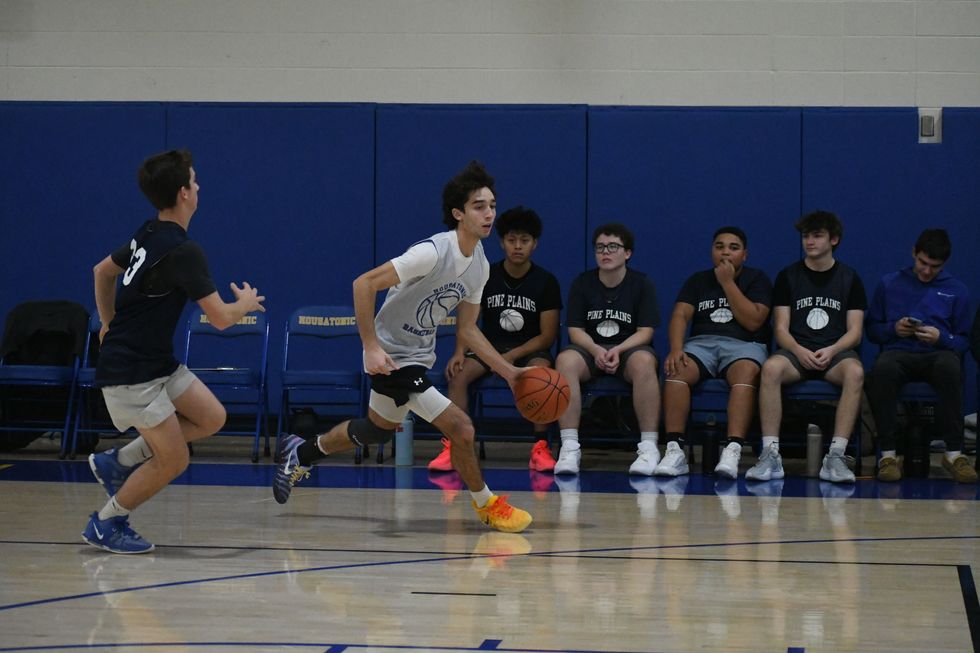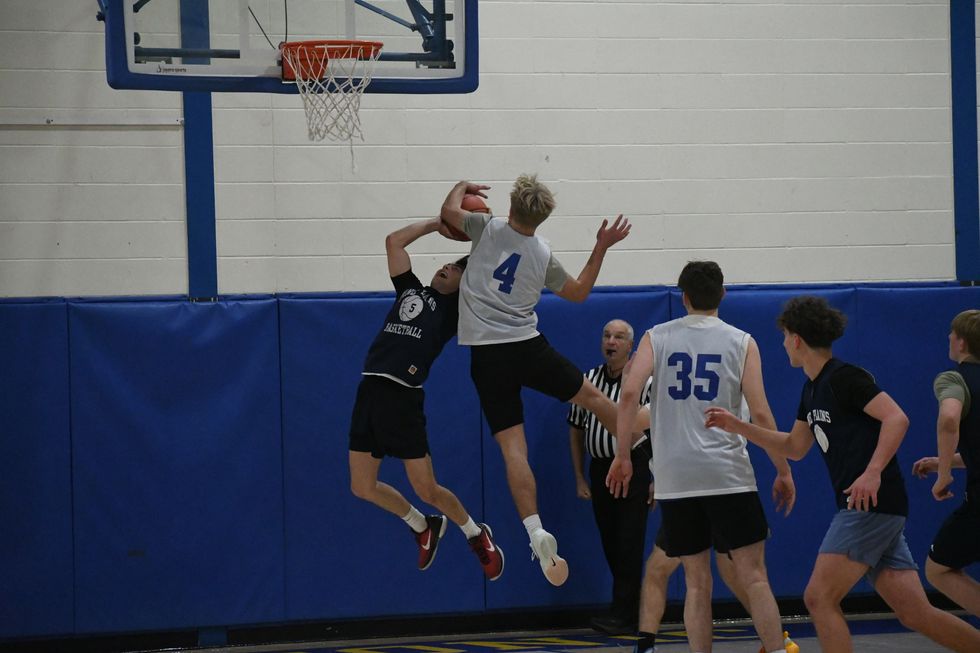The Little Guild kept tails wagging

Staff at The Little Guild in West Cornwall practiced social distancing as they continued to care for (and find homes for) dogs and cats in 2020. Photo courtesy of The Little Guild

CORNWALL — Little Guild Executive Director Jenny Langendoerfer reported that the numbers of adoptions held steady compared with the previous successful year. In fact, she said it was a good year for pet adoptions nationwide.
The nonprofit shelter found new homes for very nearly 200 dogs and cats.
COVID-19 brought adjustments to procedures, according to Langendoerfer, who said that adoptions were by appointment only; and that volunteer support, essential to the organization, was limited by public health guidelines.
“It’s remarkable how we’ve managed to thrive in spite of it all,” Langendoerfer said.
A cat success story is that of Eclipse, who arrived at The Little Guild with a full complement of her kittens all jammed together in a small carrying case — all of them understandably terrified.
Having been homeless for 18 months before her arrival in Cornwall, for an additional 466 days she resided under the care of The Little Guild and in that time developed a firm friendship with a fellow feline, Princess. It was that bond that restored her good nature and ability to trust again. Both cats were adopted together by a local family and are equally loved in their new home.
Anticipating that 2021 will bring reinvigorated programs and community outreach, Langendoerfer said that the new year has brought a new president for the organization. Karen Doeblin was elected in late 2020 to serve as president of the Board of Directors. Doeblin is succeeding John Guenther, following his six-year tenure.
Langendoerfer praised Doeblin as “a positive force” possessing a gift for strategic thinking, and above all demonstrating an abiding love for animals.
Returning to the organization as an officer will be Justin Vagliano, whose past service included the executive director’s position. Four new board members were elected: Katherine O’Brien, Joan Osofsky, David Ott and Betsy Vorce.
It was the traditional Great Country Mutt Show in 2019 that attracted Doeblin to The Little Guild and its programs, although she and her family had adopted pets from the organization in years past. She said that she anticipates that “fabulous events” will be scheduled as soon as possible in the post-pandemic future.
Having spent 20 years weekending in Litchfield County, Doeblin is now settled as a permanent resident of Cornwall. Her love of animals has spanned her lifetime and her adopted pets have been readily included as family members.
Managing to look ahead beyond the time of COVID-19, Langendoerfer is confident that The Little Guild will continue to thrive, thanks in large part to the many area residents who care about and support the organization.
In particular, the volunteer dog-walkers have been able to continue their program, as their activities can occur outdoors. She said that the organization is “amazingly fortunate” to benefit from the dedication of its volunteers.
The Salisbury Winter Sports Association (SWSA) will host its annual Junior Jump Camp, a two-day introduction to ski jumping, on Saturday and Sunday, Dec. 27 and 28, from 9 a.m. to 2 p.m. at Satre Hill in Salisbury.
The camp is open to children ages 7 and up and focuses on teaching the basics of ski jumping, with an emphasis on safety, balance and control, using SWSA’s smallest hill. No prior experience is required.
The cost is $50 per child and includes instruction and lunch on both days. For more information or to register, visit www.skireg.com/swsa-camp or email info@jumpfest.org
Jesse Bunce, first selectman of North Canaan.
LITCHFIELD — The Northwest Hills Council of Governments welcomed six newly elected municipal leaders Thursday, Dec. 11, at its first meeting following the 2025 municipal elections.
The council — a regional planning body representing 21 towns in northwest Connecticut — coordinates transportation, emergency planning, housing, economic development and other shared municipal services.
Barkhamsted First Selectman Meaghan Cook, Goshen First Selectman Seth Breakell, Kent First Selectman Eric Epstein, Norfolk First Selectman Henry Tirrell, North Canaan First Selectman Jesse Bunce and Torrington Mayor Molly Spino were each elected to their post in November.
They filled the seats of their predecessors on the COG, who were each given a toast of appreciation: Nick Lukiwsky (Barkhamsted), Todd Carusillo (Goshen), Marty Lindenmeyer (Kent), Matt Riiska (Norfolk), Brian Ohler (North Canaan) and Elinor Carbone (Torrington).
COG Executive Director Rob Phillips said the outgoing members were given a going away mug that read “You’re living the dream still.” Members voted to appoint Warren First Selectman Greg LaCava to fill a vacancy on the Council’s Executive Committee. COG members voted by paper ballot, and LaCava defeated Burlington First Selectman Doug Thompson for the vacant seat.
Ryan Segalla takes a fadeaway shot over a defender.
FALLS VILLAGE — Housatonic Valley Regional High School’s boys basketball team defeated Pine Plains High School 60-22 in a scrimmage Tuesday, Dec. 9. The non-league preseason game gave both sides an opportunity to run the court ahead of the 2025-26 varsity season.
HVRHS’s senior-heavy roster played with power and poise. The boys pulled ahead early and kept their foot on the gas through to the end.
By halftime the score was 33-8. Junior varsity players subbed in for the second half, but not before the starters got some in-game dunk practice. By the end Housatonic totaled 60 points to Pine Plains’ 22.

Nick Crodelle led the Mountaineers offensively with 13 points. Anthony Labbadia and Wyatt Bayer scored nine points each. Anthony Foley scored eight points. Owen Riemer and Ryan Segalla each scored seven points. Peyton Bushnell hit a three-pointer. Jaxon Visockis and Henry Berry each scored two points.
HVRHS begins Berkshire League competition on the road at Nonnewaug High School Tuesday, Dec. 16, with a 6 p.m. tip off.


Katie Moore delivers toys to the Stuff a Truck campaign held by the Kent Volunteer Fire Department last weekend. Donated toys are collected so that parents, who need some assistance, may provide their children with gifts this Christmas. Accepting the donation are elves Fran Goodsell and Karen Iannucci
KENT — Santa’s elves were toasty warm as they collected toys for the children of Kent.
Keeping with annual tradition, Fran Goodsell and Karen Iannucci manned the Stuff a Truck campaign sponsored by the Kent Volunteer Fire Department on Saturday, Dec. 6, and Sunday, Dec. 7. Sitting in front of a fire pit in the firehouse parking lot between donations from residents, they spoke of the incredible generosity displayed every season. That spirit of giving was clear from the piles of toys heaped on a table.
“This is always so gratifying,” said Goodsell, noting that certain businesses, including High Watch Recovery Center, Wilson’s, and Kent and South Kent schools needed a “shout out” for all they’ve done. She said South Kent School focuses on gifts for older children, which is a group that often is overlooked.
Unwrapped contributions are sought for children 1 to 15 years old who might otherwise find little or nothing from Santa, they said. The bounty will be set up at the Community House on Thursday, allowing parents to come and take what they want. If there are still items left, grandparents are invited to “shop.”
The atmosphere was festive Saturday, as a stuffed dog began barking a Christmas tune whenever someone walked in front of it. A large decked-out bear posted at the parking lot entrance reminded passersby of the event. Visiting children were able to get a close-up look at the fire truck and walk through the firehouse if they wished.
Goodsell and Iannucci were very grateful to those who donated wood for the fire pit. “And so many asked if they could bring us coffee or hot chocolate,” said Iannucci.
Goodsell said many who came talked about having grown children who were recipients of the gifts when their families were struggling. “They are so glad to be able to give back,” she said.